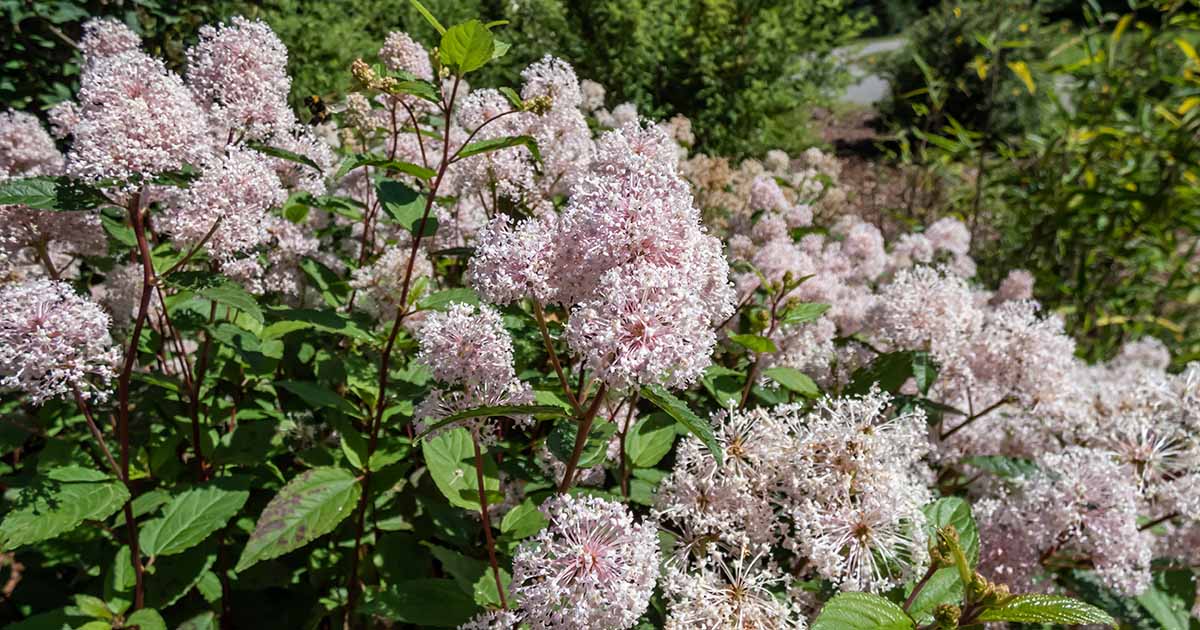
Ceanothus americanus
Ranging across the prairies, open glades, woodlands and lakeshores of eastern North America, New Jersey tea (Ceanothus americanus) is an adaptable, tenacious flowering shrub.
New Jersey tea produces pale, pillowy blossoms in spring and early summer. Lightly fragrant, the flowers attract butterflies, bees, wasps, and beetles.

We link to vendors to help you find relevant products. If you buy from one of our links, we may earn a commission.
Drought-tolerant, cold hardy, and fire resistant, this shrub is an excellent choice for dry, rocky sites. As low maintenance as a shrub can be, New Jersey tea can thrive just about anywhere with freely draining soil.
Read on to learn more about growing this durable, North American native shrub. Here’s what I’ll cover:
What Is New Jersey Tea?
A member of the buckthorn family, Rhamnaceae, New Jersey tea is related to a number of species prized in horticulture, such as the California lilacs (Ceanothus spp.) and buckthorns (Rhamnus spp.).
New Jersey tea shares these popular plants’ drought tolerance and knack for surviving in tough, rocky soils.

Hardy in USDA Zones 4 to 8, C. americanus can grow to about five feet tall and wide.
Sporting broad, toothed, four-inch-long leaves, this flowering shrub makes a good hedge thanks to its dense foliage.
The best part of New Jersey tea is its flowers. Emerging in late spring to early summer, this species produces clusters of small, sweet smelling, white to pinkish blossoms.
Beloved by bees and other pollinators, C. americanus is an excellent choice for a wildlife garden.

C. americanus has a history of medicinal use among native American peoples.
The red roots, made into a tea, have been used to soothe gastrointestinal upset, toothache, and respiratory problems. The common name, New Jersey tea, refers to the use of the leaves as a substitute for black tea by revolutionary soldiers.
Keep reading to learn how to get this tough, North American shrub established in your own garden.
New Jersey Tea Propagation
New Jersey tea can be propagated from seed, via stem cuttings, or you can purchase a transplant from the nursery.

Provided you site this shrub in a favorable location, getting C. americanus established at home is straightforward.
From Seed
C. americanus seed can be acquired either by purchasing from a reputable vendor or collecting seeds from an existing plant.
New Jersey tea produces angular, three lobed fruits which stand erect on straight stems. The fruits turn black when ripe. Highly visible to birds, they tend to disappear as soon as they ripen, making it a bit tricky to collect the seeds.
In early fall, you can try placing a mesh bag around some of the fruits to prevent the birds from consuming them. This will allow sunlight to penetrate and allow the seed to set, but will keep hungry birds out.
Remember, only collect 10 percent of the seed from your target shrub. This will ensure enough is left behind to feed wildlife and perpetuate the next generation of wild plants.
Growing this hardy North American native from seed is a little easier than some of our other native shrubs as the seed does not require cold stratification.
After collection, you can store the seed in a paper envelope or breathable bag somewhere cool and relatively dry for the winter and sow in spring.
You can improve the germination rate of New Jersey tea seeds by soaking them in water heated to 180°F prior to sowing.
Begin this process once spring arrives and daytime temperatures are mild, with the nights no longer dipping below freezing. Submerge your seeds in warm water and leave them overnight to soak, as the water gradually cools off.
Prepare a flat of moist potting soil and liberally scatter your soaked seeds across the surface. Tamp the seed down with the palm of your hand to ensure good soil contact. Gently cast a handful of soil over the seed to barely cover it.
Place your flat outside in a sheltered location after all risk of frost has passed. Make sure it receives adequate protection from any temperature extremes or high winds. Keep the soil moist, but not soaking, while you wait for germination.
After a month or two, depending on how many seedlings have appeared, you may need to thin them out. I like to make sure I have about an inch between each seedling.
Come mid to late summer, pot up the most robust individuals into four-inch pots filled with moistened potting soil.
Keep them outdoors protected from high winds and extreme temperature fluctuations before transplanting into the garden the following spring.
From Cuttings
New Jersey tea can be propagated from softwood cuttings collected in late spring. Harvest a six inch piece of soft, pliable growth using sharp, clean pruners.
Be sure to make your cut just below a pair of leaf nodes. Remove all but the two top leaves from the stem.
Prepare several four-inch pots with a mixture of equal parts sterile compost, potting soil, and sand.
Dip the bottom two inches of your cuttings into powdered rooting hormone such as this one from Gardener’s Supply.
Using a pencil, make a guide hole in the center of each of your pots, then gently insert your dipped cuttings into the hole, pressing the soil firmly around them.
Although C. americanus prefers dry soil once established, its substrate must stay consistently moist during the six to eight weeks it takes for the cuttings to root.
You may want to place a clear plastic bag over your pots to help trap moisture and maintain humidity, or, you can attentively water once a day. I prefer to do this, personally, as the better air circulation without a plastic tent helps to keep fungal infections from establishing.
Place your cuttings in a sheltered location outside where they will be protected from high winds and extreme temperature fluctuations. By the fall, your new plants will be adequately rooted and can be transplanted into the garden.
You can check whether they have rooted by gently tugging on the stem, if you feel some resistance, that’s a sign of root formation.
Transplanting
To transplant your seedlings, rooted cuttings, or nursery starts, find a spot in your garden with freely draining soil and plenty of sunlight.
Dig a hole just a little bit wider than the container your plant is currently growing in. Make sure the hole is as deep as the plant’s root ball. You want the very bottom of its trunk to be level with the ground once planted.
If your soil is poor or sandy, toss a couple of shovels of compost into the hole. New Jersey tea can manage sandy and rocky soils, but it will perform better and establish more quickly if given a nutrient boost at planting time. Back fill with regular soil and water in well.
In the absence of rain, make sure to water your New Jersey tea at least once a week for its first summer. This is good practice for any and all newly planted shrubs.
A little extra hydration will help your plant grow strong roots and become established quickly. In its second year, once established, New Jersey tea doesn’t require this kind of maintenance.
How to Grow New Jersey Tea
The achilles heel of New Jersey tea is too much water. If you plant this unfussy shrub somewhere with consistently wet soil its roots will start to rot.
Instead, make sure you choose somewhere in your landscape that tends to be dry. The beauty of C. americanus is its utility in these otherwise difficult spots. This species has the ability to improve the soil by fixing nitrogen.

Preferring sandy loam, C. americanus fares perfectly fine in the average soil of a garden bed, just so long as you don’t overwater.
In fact, this North American native does well in these conditions, thriving in freely draining, nutrient-rich soils.
Make sure you situate your shrub somewhere with ample sunlight. C. americanus won’t mind a little afternoon shade but you’ll notice more prolific flowers if you provide it with a full eight hours of sun a day.
The deep, thick roots give this shrub incredible protection from lengthy periods of drought. Unless your dry spell spans more than a couple of weeks, you don’t need to worry about watering New Jersey tea at all.
What you do need to think about, however, is a good permanent spot for this shrub.
Once established, the substantial roots, which can grow up to eight inches thick, make transplanting to a different spot impossible.
Growing Tips
- Plant in freely draining soils.
- Site in a location with full sun or a little afternoon shade.
- Water well during any very dry periods.
- Do not attempt to transplant once established.
Pruning and Maintenance
There’s really not a lot to do when it comes to taking care of New Jersey tea.
Although this native shrub will do well in dry, rocky, or sandy soils, it will benefit from applications of compost during the growing season.
Particularly if your shrub is looking a little sad, with thinning leaves and a lack of blossoms, add two inches of compost to the top of the soil around its roots in spring and summer.

Pruning is not necessary to maintain the vigor of C. americanus, but if you’re growing this native as a screen or hedge, you can train it to grow more densely by pruning.
Remove any dead branches as necessary throughout the year and, during early winter, take any tall, straight growth from the top of the plant down about six inches, to a pair of strong, healthy leaf buds.
To learn more about the basics of pruning, check out our guide.
Where to Buy
You can usually find C. americanus at reputable native plant nurseries.
Try searching for it in late spring, when the shrub is just about ready to bloom. Nurseries like to stock their shelves with plants when they’re looking their absolute best.
Most big box stores or garden centers won’t carry C. americanus, but sometimes they can order in special requests if you ask nicely.
If you prefer shopping online, you can find C. americanus available at Nature Hills Nursery in #1 containers.
Managing Pests and Disease
A wonderfully trouble free, North American native, New Jersey tea is bothered by very little in the pest and disease department.
Unfortunately, however, herbivores love it.
Herbivores
Rabbits, deer, elk, and moose all browse this apparently delectable species.
However, providing forage for wildlife is part of the reason we grow native plants. Protect young shrubs with a wide, upright ring of chicken wire until they’re at least five years old and able to withstand a little nibbling.
If browsing becomes severe, which is unlikely, the only way to thwart herbivores like deer is to build a six- to eight-foot-tall fence.
Disease
Just like any other plant, if you grow New Jersey tea in the wrong place, problems will follow.
When properly sited in a sunny spot, with well-draining soil, there are only a couple diseases to keep an eye out for.
Leaf Spot
Mainly a problem in damp conditions, or during wet, rainy summers, New Jersey tea can suffer from leaf spot.
This condition is caused by an array of different fungi and results in blemishes on the foliage ranging from yellow to brown to black. Leaf spot is an aesthetic problem, and rarely leads to any significant issues.
To control leaf spot, remove any affected leaves or leaf litter and dispose of them in the trash.
Powdery Mildew
A common disease of plants grown in dry, shady conditions, powdery mildew is caused by a number of different fungi.
This condition is characterized by a white to gray powder coating the upper surface of leaves that, sometimes, in severe cases, causes premature leaf drop.
If you catch powdery mildew early, when just a few pale spots appear on foliage, quickly remove any affected leaves and discard them in the trash. Reducing the amount of diseased leaf litter lying around will help eliminate fungal spores, too.
Plants often become susceptible to powdery mildew when they’re under stress.
If you’ve been watering your New Jersey tea, trying to help it through a difficult dry spell, make sure you water at the base of the plant, and not from overhead.
Water droplets on the leaves will only serve to spread the fungus.
To learn more about identifying and controlling this common garden problem, check out our guide to powdery mildew.
Best Uses for New Jersey Tea
Tolerant of a wide variety of difficult landscape conditions, New Jersey tea is a versatile plant. Try it in a sandy bed, on a rocky slope, or as an anchor shrub within a garden border.

Although C. americanus can thrive in some pretty inhospitable situations, don’t plant it too far from your garden.
Once those sweet smelling flowers arrive you’ll want it close by to enjoy this shrub to the fullest.
In addition, this shrub is tolerant of juglone, so it can be planted near black walnut trees.
Quick Reference Growing Guide
| Plant Type: | Woody flowering shrub | Flower/Foliage Color: | Pink, pinkish-white, white / dark green |
| Native to: | North America | Maintenance: | Low |
| Hardiness (USDA Zones): | 4-8 | Tolerance | Alkaline or average soil, heat, juglone, part shade, sandy soil, salt |
| Bloom Time: | Late spring/early summer | Soil Type: | Sandy, rocky, loose, loamy |
| Exposure: | Full sun to part shade | Soil pH: | 6.0-7.0 |
| Time to Maturity: | 3 years | Soil Drainage: | Well-draining |
| Spacing: | 5 feet | Attracts: | Bees, beetles, birds, butterflies, hummingbirds, wasps |
| Planting Depth: | Surface sow (seeds), same depth as growing container (transplants) | Uses: | Native plant garden, naturalized areas, rock garden, wildlife garden, woodland edge |
| Height: | Up to 5 feet | Order: | Rosales |
| Spread: | Up to 5 feet | Family: | Rhamnaceae |
| Water Needs: | Low | Genus: | Ceanothus |
| Common Pests and Diseases: | Deer; leaf spot, powdery mildew | Species: | Americanus |
No Nonsense Native
Versatile and tough as nails, New Jersey tea is just as easy to grow as many of the most popular shrubs in horticulture.
C. americanus is a native species, and that makes a big difference. Grow this North American shrub in your garden and not only enjoy a plant that can thrive in that tricky, rocky area, but you’ll be rewarded with a visual feast of birds, bees, butterflies, and beetles that depend on this plant for food.

Gardening with hardy, durable natives means less maintenance for us humans, and more nourishment for all the animals and insects that live around us.
Now it’s your turn to tell us about New Jersey tea! Have you seen or smelled this beautiful plant growing in the wild? Do you grow it in your garden? How’s it going? Let us know in the comments section below!
And to learn more about growing other native shrubs, check out these guides next:







